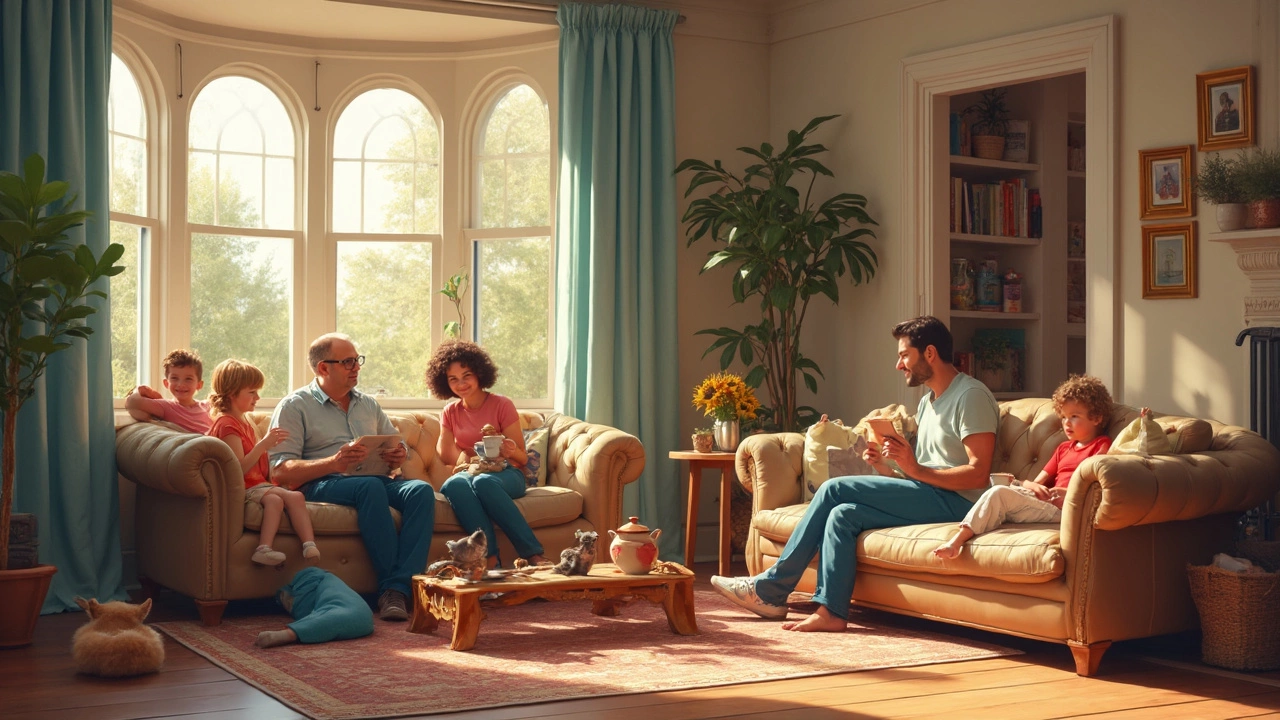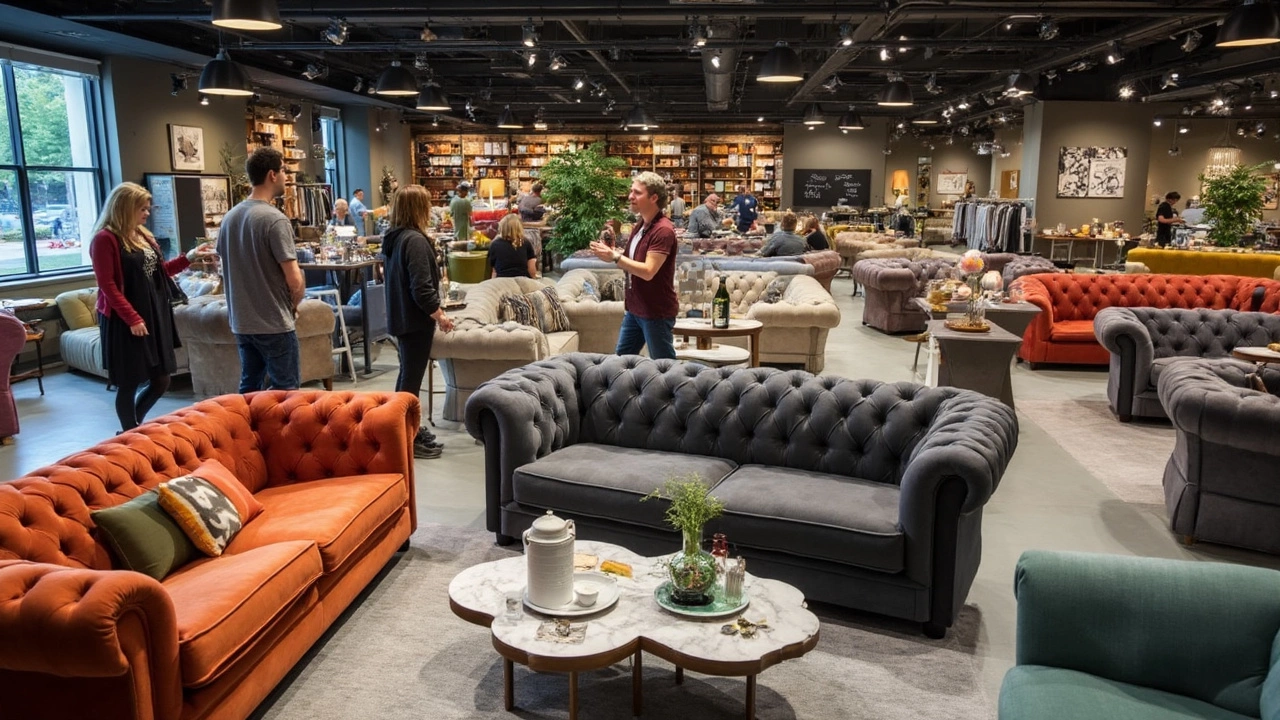Which Type of Sofa Is Best? Your Real-Life Guide
 Jun, 22 2025
Jun, 22 2025
Walk into any furniture store and the choices are endless—sectionals, love seats, sleeper sofas, recliners. Not every living room needs a giant sectional, and not every house is built for those tiny love seats. So how do you figure out what’s actually best for your space and your routine?
Start by being honest with yourself: is the sofa for movie nights and Sunday naps, or do you just need something that looks good for guests? If you have pets or kids, durability has to be a bigger deal than style. Materials make a huge difference—some fabrics fend off stains and claws, while others look great but wear out fast. Don’t ignore things like seat depth, firmness, and whether there’s enough space to stretch out or curl up. The right choice depends way more on your real life than on what you see in glossy catalogs.
- Breaking Down Sofa Types
- Building Materials: What Really Holds Up?
- Choosing for Comfort and Space
- Tips for Real-Life Sofa Shopping
Breaking Down Sofa Types
If you think all sofas do the same thing, wait until you try cramming a big sectional into a small apartment or buying a gorgeous but uncomfortable antique for your game room. Each sofa style does a different job, so let’s map out the main types you’re most likely to see today.
- Sectional Sofas: The big L- or U-shaped couches you see in family rooms. These are the go-to for movie night and group hangouts. You get lots of seating and can even split them apart in some cases. If you’ve got space and a busy household, it’s hard to top a sectional.
- Sleeper Sofas: These do double duty. By day, it’s a normal couch—by night, it turns into a bed. Great if you don’t have a guest room but occasionally need one. Most sleep sofas use queen or full-size mattresses, but some are more comfortable than others.
- Loveseats: These smaller sofas seat two and fit well in apartments or small spaces. If your living room is tight or you’re furnishing a cozy reading nook, a loveseat gets the job done without hogging the floor.
- Reclining Sofas: If you’re after comfort and a spot to kick back after a long day, reclining sofas have your back. Some have power recliners, hidden USB ports, or even built-in drink holders—pretty handy for binging your favorite shows.
- Chesterfield and Tuxedo Sofas: These styles are about looks. Think high, rolled arms and deep button tufting (that’s a chesterfield) or straight, low backs for the tuxedo variety. If you want a standout piece that feels a bit upscale, these designs do the trick, but they might not be the coziest pick.
Each sofa type brings its own pros and cons to the table—literally. To make things clearer, here’s how they compare on core features:
| Sofa Type | Main Use | Best Room Size | Typical Price Range (USD) |
|---|---|---|---|
| Sectional | Family/Group Seating | Medium to Large | $1,000 - $4,000 |
| Sleeper Sofa | Occasional Guests | Any, varies by size | $600 - $2,500 |
| Loveseat | Small Spaces | Small to Medium | $300 - $1,200 |
| Reclining Sofa | Relaxation/TV Watching | Medium to Large | $700 - $2,800 |
| Chesterfield | Style Statement | Medium to Large | $900 - $3,500 |
Think about how you’ll actually use the sofa in your day-to-day life. Don’t just go for what looks trendy now—choose what you’ll enjoy sitting on five years from now and makes the most sense for your space, your people, and your usual routine. The best sofa is the one that fits your life, not someone else’s Instagram feed.
Building Materials: What Really Holds Up?
If there’s one thing that turns a good sofa into a waste of money, it’s flimsy building materials. The frame does all the heavy lifting, so that’s where you want strength. Hardwood frames, like oak or maple, are the gold standard. They don’t warp or break easily. Cheap sofas often use particleboard or plastic—these are basically asking for saggy cushions and wobbly arms after a couple of years.
Cushion filling matters, too. High-density foam keeps its shape way longer than low-density foam. If you see feather- or down-filled cushions, those feel plush but need constant fluffing and eventually flatten out. Memory foam is getting more popular in sofa types since it resists sagging and supports your back better.
Fabric can make or break your couch’s lifespan. Polyester and microfiber are kings when it comes to fighting stains and holding up to rough play. Leather is durable but needs real maintenance—think regular cleaning and conditioner, especially if you have pets or sunlight streaming in. Velvet feels high-end, but it attracts dust and hair. Here’s a cheat sheet to compare:
| Material | Must-Know Facts | Best For |
|---|---|---|
| Hardwood Frame | Lasts 7-15 years, resists warping | High-use homes |
| Particleboard Frame | Cheap, lasts 1-4 years | Short-term use, low budgets |
| High-Density Foam | Holds shape 5+ years | Everyday lounging |
| Feather/Down Filling | Feels plush, flattens fast | Formal areas |
| Polyester/Microfiber | Pet/kid-friendly, stain-resistant | Busy families |
| Leather | Durable, needs maintenance | Style, long-term investment |
| Velvet | Looks premium, collects debris | Low-traffic spaces |
Remember, the cheaper the sofa, the more likely you’ll be chunking it at the curb sooner rather than later. Always peek under the cushions—if there’s a lot of creaking or you see staples instead of screws and dowels, that’s a red flag. Quality stitching on fabric, and zippers instead of glue on cushions, are small signs the thing is built to last.

Choosing for Comfort and Space
The easiest way to wreck your living room vibe is to buy a sofa that doesn’t fit your life or your space. Most folks don’t measure before buying, and that’s a classic mistake. Sofas usually range from about 72 to 90 inches wide, which sounds all right—until you try to wedge one through a hallway or around a tight corner. Always check your doorways, and leave a bit of breathing room on each side of the sofa for side tables or just to avoid the squeezed look.
Now, let’s talk comfort. There’s no single answer to what feels right, but there are some clear rules. Deep seats (think 23 inches or more) are awesome for tall people or anyone who loves to nap; shallow seats (20-22 inches) work better for folks who need good back support or have small spaces. If you’re serious about lounging, sectionals and chaises let you stretch out without fighting for legroom. If your living room is tiny, a loveseat or apartment-sized sofa saves space without sacrificing style or basic comfort.
Arm style might sound trivial, but it changes everything. Flat, low arms can work as headrests or laptop spots, while high rolled arms feel more classic and are better for propping up pillows. Removable cushions are a plus if you want deep cleaning or sometimes crash on the couch. Cushions filled with high-density foam hold their shape longer, while softer fillings might lose their bounce in a busy household.
Here are quick tips to boost both comfort and function:
- Map out your room with painter’s tape to see the real footprint.
- Test seat depth and firmness in-store if you can—what looks good online sometimes disappoints in real life.
- If you have overnight guests, a sleeper sofa or a sectional with a chaise adds hidden sleeping space.
- If your main issue is clutter, pick a sofa with built-in storage—these are lifesavers for throw blankets and remote controls.
Last thing: pick the best sofa for your habits, not just your eyes. The most stylish sofa in the world means nothing if you can’t get comfortable—or, worse, it won’t fit through your door.
Tips for Real-Life Sofa Shopping
If you’re about to drop serious cash on a new sofa, it pays to do more than just check the color. Beyond picking out what looks good, you need to think about what will last, feel right, and actually fit in your space. Here’s how to up your sofa game without getting overwhelmed.
- Measure Twice: This sounds basic, but people mess it up all the time. Measure your living room—including doorways, stairs, and the elevator if you’re in an apartment. Nothing stings like a sofa that gets stuck in the hallway.
- Fabric Really Matters: Microfiber is the real MVP for pet hair and kid messes. Leather holds up too, but watch out for scratches. Linen looks sharp, but it stains easily. Most furniture stores admit that over 60% of returns and complaints come from fabric wear and tear.
- Cushion Test: Foam keeps its shape, but high-resilience (HR) foam will last years longer than the cheap stuff. Down feels fancier, but it needs regular fluffing, or it slumps. If you can, unzip the cushions and peek inside.
- Frame Check: Hardwood frames like oak or beech will take a beating. Particleboard and softwoods aren’t as tough. A solid frame is non-negotiable for a sofa’s durability.
Money isn’t everything, but sometimes you get what you pay for. Here’s a handy table to show how much longer better materials last—based on a few real-world averages:
| Material | Expected Lifespan |
|---|---|
| Microfiber | Up to 10 years |
| Leather | 10–15 years |
| Basic Foam Cushions | 3–5 years |
| High-Resilience Foam | 7–10 years |
| Hardwood Frame | 15+ years |
Don’t forget the boring stuff like warranties. Stick to places that give you at least a one-year warranty on the frame and cushions. And always, always sit on the sofa before you buy—store models can feel different from what’s delivered, but it beats buying blind online.